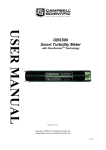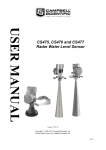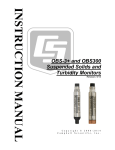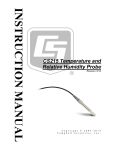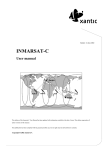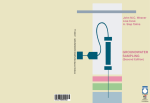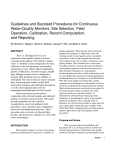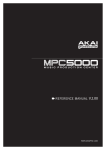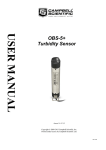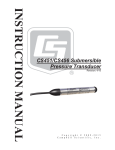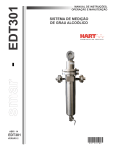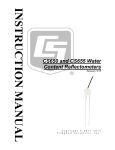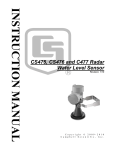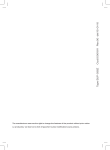Download OBS501 Smart Turbidity Meter
Transcript
USER MANUAL OBS501 Smart Turbidity Meter with ClearSensor Technology Issued: 21.7.15 Copyright © 2008-2015 Campbell Scientific, Inc. Printed under licence by Campbell Scientific Ltd. CSL 1085 Guarantee This equipment is guaranteed against defects in materials and workmanship. This guarantee applies for 24 months from date of delivery. We will repair or replace products which prove to be defective during the guarantee period provided they are returned to us prepaid. The guarantee will not apply to: Equipment which has been modified or altered in any way without the written permission of Campbell Scientific Batteries Any product which has been subjected to misuse, neglect, acts of God or damage in transit. Campbell Scientific will return guaranteed equipment by surface carrier prepaid. Campbell Scientific will not reimburse the claimant for costs incurred in removing and/or reinstalling equipment. This guarantee and the Company’s obligation thereunder is in lieu of all other guarantees, expressed or implied, including those of suitability and fitness for a particular purpose. Campbell Scientific is not liable for consequential damage. Please inform us before returning equipment and obtain a Repair Reference Number whether the repair is under guarantee or not. Please state the faults as clearly as possible, and if the product is out of the guarantee period it should be accompanied by a purchase order. Quotations for repairs can be given on request. It is the policy of Campbell Scientific to protect the health of its employees and provide a safe working environment, in support of this policy a “Declaration of Hazardous Material and Decontamination” form will be issued for completion. When returning equipment, the Repair Reference Number must be clearly marked on the outside of the package. Complete the “Declaration of Hazardous Material and Decontamination” form and ensure a completed copy is returned with your goods. Please note your Repair may not be processed if you do not include a copy of this form and Campbell Scientific Ltd reserves the right to return goods at the customers’ expense. Note that goods sent air freight are subject to Customs clearance fees which Campbell Scientific will charge to customers. In many cases, these charges are greater than the cost of the repair. Campbell Scientific Ltd, 80 Hathern Road, Shepshed, Loughborough, LE12 9GX, UK Tel: +44 (0) 1509 601141 Fax: +44 (0) 1509 601091 Email: [email protected] www.campbellsci.co.uk PLEASE READ FIRST About this manual Please note that this manual was originally produced by Campbell Scientific Inc. primarily for the North American market. Some spellings, weights and measures may reflect this origin. Some useful conversion factors: Area: 1 in2 (square inch) = 645 mm2 Length: Mass: 1 in. (inch) = 25.4 mm 1 ft (foot) = 304.8 mm 1 yard = 0.914 m 1 mile = 1.609 km 1 lb (pound weight) = 0.454 kg Pressure: 1 psi (lb/in2) = 68.95 mb Volume: 1 UK pint = 568.3 ml 1 UK gallon = 4.546 litres 1 US gallon = 3.785 litres 1 oz. (ounce) = 28.35 g In addition, while most of the information in the manual is correct for all countries, certain information is specific to the North American market and so may not be applicable to European users. Differences include the U.S standard external power supply details where some information (for example the AC transformer input voltage) will not be applicable for British/European use. Please note, however, that when a power supply adapter is ordered it will be suitable for use in your country. Reference to some radio transmitters, digital cell phones and aerials may also not be applicable according to your locality. Some brackets, shields and enclosure options, including wiring, are not sold as standard items in the European market; in some cases alternatives are offered. Details of the alternatives will be covered in separate manuals. Part numbers prefixed with a “#” symbol are special order parts for use with non-EU variants or for special installations. Please quote the full part number with the # when ordering. Recycling information At the end of this product’s life it should not be put in commercial or domestic refuse but sent for recycling. Any batteries contained within the product or used during the products life should be removed from the product and also be sent to an appropriate recycling facility. Campbell Scientific Ltd can advise on the recycling of the equipment and in some cases arrange collection and the correct disposal of it, although charges may apply for some items or territories. For further advice or support, please contact Campbell Scientific Ltd, or your local agent. Campbell Scientific Ltd, 80 Hathern Road, Shepshed, Loughborough, LE12 9GX, UK Tel: +44 (0) 1509 601141 Fax: +44 (0) 1509 601091 Email: [email protected] www.campbellsci.co.uk Precautions DANGER — MANY HAZARDS ARE ASSOCIATED WITH INSTALLING, USING, MAINTAINING, AND WORKING ON OR AROUND TRIPODS, TOWERS, AND ANY ATTACHMENTS TO TRIPODS AND TOWERS SUCH AS SENSORS, CROSSARMS, ENCLOSURES, ANTENNAS, ETC. FAILURE TO PROPERLY AND COMPLETELY ASSEMBLE, INSTALL, OPERATE, USE, AND MAINTAIN TRIPODS, TOWERS, AND ATTACHMENTS, AND FAILURE TO HEED WARNINGS, INCREASES THE RISK OF DEATH, ACCIDENT, SERIOUS INJURY, PROPERTY DAMAGE, AND PRODUCT FAILURE. TAKE ALL REASONABLE PRECAUTIONS TO AVOID THESE HAZARDS. CHECK WITH YOUR ORGANIZATION'S SAFETY COORDINATOR (OR POLICY) FOR PROCEDURES AND REQUIRED PROTECTIVE EQUIPMENT PRIOR TO PERFORMING ANY WORK. Use tripods, towers, and attachments to tripods and towers only for purposes for which they are designed. Do not exceed design limits. Be familiar and comply with all instructions provided in product manuals. Manuals are available at www.campbellsci.eu or by telephoning +44(0) 1509 828 888 (UK). You are responsible for conformance with governing codes and regulations, including safety regulations, and the integrity and location of structures or land to which towers, tripods, and any attachments are attached. Installation sites should be evaluated and approved by a qualified engineer. If questions or concerns arise regarding installation, use, or maintenance of tripods, towers, attachments, or electrical connections, consult with a licensed and qualified engineer or electrician. General • Prior to performing site or installation work, obtain required approvals and permits. Comply with all governing structure-height regulations, such as those of the FAA in the USA. • Use only qualified personnel for installation, use, and maintenance of tripods and towers, and any attachments to tripods and towers. The use of licensed and qualified contractors is highly recommended. • Read all applicable instructions carefully and understand procedures thoroughly before beginning work. • Wear a hardhat and eye protection, and take other appropriate safety precautions while working on or around tripods and towers. • Do not climb tripods or towers at any time, and prohibit climbing by other persons. Take reasonable precautions to secure tripod and tower sites from trespassers. • Use only manufacturer recommended parts, materials, and tools. Utility and Electrical • You can be killed or sustain serious bodily injury if the tripod, tower, or attachments you are installing, constructing, using, or maintaining, or a tool, stake, or anchor, come in contact with overhead or underground utility lines. • Maintain a distance of at least one-and-one-half times structure height, or 20 feet, or the distance required by applicable law, whichever is greater, between overhead utility lines and the structure (tripod, tower, attachments, or tools). • Prior to performing site or installation work, inform all utility companies and have all underground utilities marked. • Comply with all electrical codes. Electrical equipment and related grounding devices should be installed by a licensed and qualified electrician. Elevated Work and Weather • Exercise extreme caution when performing elevated work. • Use appropriate equipment and safety practices. • During installation and maintenance, keep tower and tripod sites clear of un-trained or non-essential personnel. Take precautions to prevent elevated tools and objects from dropping. • Do not perform any work in inclement weather, including wind, rain, snow, lightning, etc. Maintenance • Periodically (at least yearly) check for wear and damage, including corrosion, stress cracks, frayed cables, loose cable clamps, cable tightness, etc. and take necessary corrective actions. • Periodically (at least yearly) check electrical ground connections. WHILE EVERY ATTEMPT IS MADE TO EMBODY THE HIGHEST DEGREE OF SAFETY IN ALL CAMPBELL SCIENTIFIC PRODUCTS, THE CUSTOMER ASSUMES ALL RISK FROM ANY INJURY RESULTING FROM IMPROPER INSTALLATION, USE, OR MAINTENANCE OF TRIPODS, TOWERS, OR ATTACHMENTS TO TRIPODS AND TOWERS SUCH AS SENSORS, CROSSARMS, ENCLOSURES, ANTENNAS, ETC. Contents PDF viewers: These page numbers refer to the printed version of this document. Use the PDF reader bookmarks tab for links to specific sections. 1. Introduction ................................................................ 1 2. Cautionary Statements .............................................. 1 3. Initial Inspection ........................................................ 1 3.1 Ships With ............................................................................................ 2 4. Quickstart ................................................................... 2 5. Overview ..................................................................... 5 5.1 5.2 5.3 5.4 Applications ......................................................................................... 5 Backscatter and Sidescatter Sensors .................................................... 5 ClearSensor® Antifouling Method ....................................................... 5 Comparison of OBS500 and OBS501 .................................................. 6 6. Specifications ............................................................ 6 7. Installation .................................................................. 7 7.1 7.2 Default Settings .................................................................................... 7 Device Configuration Utility ................................................................ 8 7.2.1 Terminal Tab................................................................................. 8 7.2.2 Setting Editor Tab ....................................................................... 10 7.2.3 Downloading a New Operating System ...................................... 10 7.3 Datalogger/RTU Connection ............................................................. 11 7.3.1 SDI-12 Wiring ............................................................................ 12 7.3.2 RS-232 Wiring ............................................................................ 12 7.3.3 Analogue 0 to 5 Volt Wiring ...................................................... 13 7.4 Programming...................................................................................... 13 7.4.1 Using Short Cut .......................................................................... 13 7.4.2 CRBasic Programming ............................................................... 13 7.4.2.1 SDI-12 .............................................................................. 14 7.4.2.2 RS-232.............................................................................. 14 7.4.2.3 Analogue .......................................................................... 14 7.4.3 Edlog Programming .................................................................... 14 7.5 Mounting Suggestions ........................................................................ 15 7.5.1 Mounting Example ..................................................................... 15 8. Operation .................................................................. 17 8.1 8.2 8.3 8.4 8.5 Turbidity Units ................................................................................... 17 Vertical-Cavity Surface-Emitting Laser Diode .................................. 18 OBS500CBL-L Connector Pin Out ................................................... 19 Measurements .................................................................................... 19 Communication Modes ...................................................................... 20 8.5.1 SDI-12......................................................................................... 20 8.5.1.1 Measuring Multiple SDI-12 Sensors ................................ 22 8.5.2 RS-232 ........................................................................................ 22 8.6 Calibration.......................................................................................... 22 8.6.1 Turbidity ..................................................................................... 22 i 8.6.2 Sediment ..................................................................................... 26 8.6.2.1 Dry-Sediment Calibration ................................................ 26 8.6.2.2 Wet-Sediment Calibration ................................................ 26 8.6.2.3 In situ Calibration ............................................................. 27 8.6.2.4 Performing a Dry-Sediment Calibration .......................... 27 8.7 Operation in High Sediment Loads and Sandy Sediments ................. 28 8.7.1 Wiper Removal Procedure .......................................................... 29 9. Maintenance ............................................................. 31 10. Troubleshooting ...................................................... 31 11. References ............................................................... 32 Appendices A. Importing Short Cut Code ..................................... A-1 A.1 Importing Short Cut Code into a Program Editor ............................A-1 A.1.1 CRBasic Datalogger .................................................................A-1 A.1.2 Edlog .........................................................................................A-2 B. Example Programs ................................................ B-1 B.1 B.2 B.3 B.4 B.5 CR6 SDI-12 Program ....................................................................... B-1 CR1000 SDI-12 Program ................................................................. B-2 CR1000 RS-232 Program ................................................................ B-3 CR1000 Analogue Program ............................................................. B-4 Examples for High Sediment Loads ................................................ B-5 B.5.1 Normally Open CR1000 Example ............................................ B-5 B.5.2 Cycle Shutter/Wiper for Each Measurement CR1000 Program B-6 C. OBS501 Copper Sleeve Kit Installation ................ C-1 D. SDI-12 Sensor Support .......................................... D-1 D.1 SDI-12 Command Basics .................................................................D-1 D.1.1 Address Query Command (?!) ..................................................D-1 D.1.2 Change Address Command (aAb!) ...........................................D-1 D.1.3 Start Measurement Commands (aM!) .......................................D-2 D.1.4 Aborting a Measurement Command .........................................D-2 D.1.5 Send Data Command (aDv!) .....................................................D-2 D.2 SDI-12 Transparent Mode ...............................................................D-2 D.2.1 CR200(X) Series Datalogger Example .....................................D-2 D.2.2 CR1000 Datalogger Example ...................................................D-3 D.2.3 CR10X Datalogger Example ....................................................D-4 E. Factors that Affect Turbidity and Suspended-Sediment Measurements ..................................................... E-1 E.1 E.2 E.3 E.4 E.5 E.6 E.7 Particle Size ..................................................................................... E-1 Suspensions with Mud and Sand ..................................................... E-2 Particle-Shape Effects ...................................................................... E-2 High Sediment Concentrations ........................................................ E-3 IR Reflectivity—Sediment Colour................................................... E-4 Water Colour.................................................................................... E-5 Bubbles and Plankton ...................................................................... E-5 ii Figures 5-1. 7-1. 7-2. 7-3. 7-4. 7-5. 7-6. 7-7. 7-8. 8-1. 8-2. 8-3. 8-4. 8-5. 8-6. 8-7. 8-8. 8-9. D-1. D-2. D-3. E-1. E-2. E-3. E-4. E-5. OBS501 sensor with the shutter open .................................................. 6 Device Configuration Utility ................................................................ 8 Terminal Mode using 1 and H commands ........................................... 9 Settings Editor screen......................................................................... 10 DevConfig, Send OS .......................................................................... 11 Use strain relief to keep stress off the cable and provide extra security ........................................................................................... 15 Apply tape to protect sensor ............................................................... 16 Secure with hose clamps; do not overtighten ..................................... 16 Place and secure mounting fixture ..................................................... 17 Orientation of emitter cone (source beam) and OBS and sidescatter detector (acceptance) cones .......................................... 18 Normalized response of OBS501 to AMCO Clear® turbidity. The inset shows the response function of a turbidity sensor to high-sediment concentrations. ........................................................ 23 Position of OBS501 in clean tap water in big black tub..................... 25 OBS501 in 500-TU AMCO Clear® turbidity standard in 100-mm black polyethylene calibration cup ................................................. 26 Portable Sediment Suspender (left) and OBS beam orientation in suspender tub (right) ....................................................................... 27 Remove the screw .............................................................................. 29 Insert screwdriver and rotate clockwise ............................................. 30 Shutter disassembled .......................................................................... 30 Shutter components ............................................................................ 30 CR200(X) example of using the SDI-12 transparent mode to change the SDI-12 address from 0 to 1........................................ D-3 CR1000 example of using the SDI-12 transparent mode to change the SDI-12 address from 3 to 1. Sensor is connected to control port 1. .............................................................................. D-4 CR10X example of using the SDI-12 transparent mode to change the SDI-12 address from 0 to 1. Sensor is connected to control port 1. .............................................................................. D-5 Normalized sensitivity as a function of grain diameter .................... E-1 The apparent change in turbidity resulting from disaggregation methods......................................................................................... E-2 Relative scattering intensities of grain shapes .................................. E-3 Response of an OBS sensor to a wide range of SSC ........................ E-4 Infrared reflectivity of minerals as a function of 10-Munzell Value ............................................................................................ E-5 iii Tables 7-1. 7-2. 7-3. 7-4 7-5. 8-1. 8-2. 8-3. 8-4. 8-5. Factory Settings ................................................................................... 7 RS-232 Terminal Commands ............................................................... 9 SDI-12 Wiring ................................................................................... 12 RS-232 Wiring ................................................................................... 12 Analogue 0-5 Volt Wiring ................................................................. 13 OBS500CBL-L Connector Pin-Out ................................................... 19 SDI-12 and RS-232 Measurement Commands .................................. 20 RS-232 Settings ................................................................................. 22 Calibration Materials and Volumes ................................................... 23 Change in TU value resulting from one hour of evaporation of SDVB standard ............................................................................... 24 10-1. Troubleshooting Chart ....................................................................... 32 D-1. OBS501 SDI-12 Command and Response Set ................................D-1 iv OBS501 Smart Turbidity Meter with ClearSensor® Technology 1. Introduction The OBS501 is a submersible turbidity meter that includes dual backscatter and sidescatter sensors, shutter mechanism that keeps the lenses clean, and a refillable biocide chamber that prevent fouling. It’s designed to prevent sand grains or packed sediment from getting wedged between the shutter and the sensor body, which inhibits the shutter’s movement. The OBS501 has three communication modes: SDI-12, RS-232, or 0 to 5 V. The mode defaults to SDI-12/RS-232 but can be set in our Device Configuration Utility (DevConfig) to analogue. As an SDI-12/RS-232 sensor, the OBS501 is shipped with an address of 0. 2. 3. Cautionary Statements READ AND UNDERSTAND the Precautions section at the front of this manual. The OBS501 needs to be sent in after two years or 70,000 cycles for drive shaft seal replacement. (See aM9! command in Table 8-2, SDI-12 and RS232 Measurement Commands (p. 20)). The sensor may be damaged if it is encased in ice. Damages caused by freezing conditions will not be covered by our warranty. Campbell Scientific recommends removing the sensor from the water for the time period that the water is likely to freeze. Minimize temperature shock. For example, do not take sensor from sunny dashboard and immediately drop it in frigid water. Ensure that obstructions are not in the backscatter sensor’s large field of view. See Section 7.5, Mounting Suggestions (p. 15), for more information. Maximum depth for the OBS501 is 100 m. The probe must be calibrated with sediments from the waters to be monitored. The procedure for calibrating the probe is provided in Section 8.6, Calibration (p. 22). Sites with high sediment loads or large sand grains can be problematic for the shutter and it’s motor. Refer to Section 8.7, Operation in High Sediment Loads and Sandy Sediments (p. 28), for more information. Remember that although the OBS501 is designed to be a rugged and reliable device for field use, it is also a highly precise scientific instrument and should be handled as such. Initial Inspection Upon receipt of the OBS501, inspect the packaging for any signs of shipping damage, and, if found, report the damage to the carrier in accordance with 1 ® OBS501 Smart Turbidity Meter with ClearSensor Technology policy. The contents of the package should also be inspected and a claim filed if any shipping-related damage is discovered. 3.1 When opening the package, care should be taken not to damage or cut the cable jacket. If there is any question about damage having been caused to the cable jacket, a thorough inspection is prudent. The model number is engraved on the housing. Check this information against the shipping documentation to ensure that the expected model number was received. Refer to the Ships With list to ensure that all parts are included (see Section 3.1, Ships With (p. 2)). Ships With (1) Calibration Certificate (1) 27752 OBS501 Spare Parts Kit (1) ResourceDVD 4. Quickstart Short Cut is an easy way to program your datalogger to measure the sensor and assign datalogger wiring terminals. The following procedure shows using Short Cut to program the OBS501. 2 1. Install Short Cut by clicking on the install file icon. Get the install file from either www.campbellsci.com, the ResourceDVD, or find it in installations of LoggerNet, PC200W, PC400, or RTDAQ software. 2. The Short Cut installation should place a Short Cut icon on the desktop of your computer. To open Short Cut, click on this icon. User Manual 3. When Short Cut opens, select New Program. 4. Select Datalogger Model and Scan Interval (default of 5 seconds is OK for most applications). Click Next. 3 ® OBS501 Smart Turbidity Meter with ClearSensor Technology 5. Under the Available Sensors and Devices list, select the Sensors | Water | Quality folder. Select OBS501 Smart Turbidity Meter. Click to move the selection to the Selected device window. Temperature defaults to degrees Celsius and the sensor are measured every scan. These can be changed by clicking the Temperature or Measure Sensor box and selecting a different option. Typically, the default SDI-12 address of 0 is used. 4 6. After selecting the sensor, click at the left of the screen on Wiring Diagram to see how the sensor is to be wired to the datalogger. The wiring diagram can be printed out now or after more sensors are added. 7. Select any other sensors you have, then finish the remaining Short Cut steps to complete the program. The remaining steps are outlined in Short Cut Help, which is accessed by clicking on Help | Contents | Programming Steps. 8. If LoggerNet, PC400, or PC200W is running on your PC and the PC to datalogger connection is active, click Finish in Short Cut and you will be prompted to send the program just created to the datalogger. User Manual 9. 5. If the sensor is connected to the datalogger, as shown in the wiring diagram in step 6, check the output of the sensor in the datalogger support software data display to make sure it is making reasonable measurements. Overview 5.1 Applications Turbidity sensors are used for a wide variety of monitoring tasks in riverine, oceanic, laboratory, and industrial settings. They can be integrated in waterquality monitoring systems, CTDs, laboratory instrumentation, and sedimenttransport monitors. The electronics of the OBS501 are housed in a Delrin ® package, which is ideal for salt water or other harsh environments. Applications include: 5.2 Compliance with permits, water-quality guidelines, and regulations Determination of transport and fate of particles and associated contaminants in aquatic systems Conservation, protection, and restoration of surface waters Assess the effect of land-use management on water quality Monitor waterside construction, mining, and dredging operations Characterization of wastewater and energy-production effluents Tracking water-well completion including development and use Backscatter and Sidescatter Sensors The heart of the OBS501 sensor is a near-infrared (NIR) laser and two photodiodes for detecting the intensity of light scattered from suspended particles in water. One detector measures the backscatter energy and the second is positioned at 90 degrees to the emitter to measure the sidescatter energy. Backscatter and sidescatter sensors have unique strengths and weaknesses. Generally speaking, backscatter provides high-range (HR) measurements, and sidescatter provides low-range (LR) measurements. The OBS501 combines both in one sensor to provide unequalled performance in a field turbidity sensor. With their unique optical design (U.S. Patent 4841157), backscatter sensors perform better than most in situ turbidity monitors in the following ways: Measure turbidity to 4000 TU (compared to 1200 TU typically for sidescatter sensors) Insensitivity to bubbles and organic matter Ambient-light rejection Low temperature coefficient Sidescatter sensors have the following advantages: 5.3 More accurate in very clean water Fixed measurement volume ClearSensor® Antifouling Method The OBS501 incorporates the ClearSensor® (U.S. Patent 8429952) anti-fouling method to prevent biofouling, which ensures better measurements in biologically active waters. This method uses a shutter/wiper mechanism to protect and clean the optics (see Figure 5-1). Additionally, biocide, stored in a refillable chamber, continuously leaches over the optics while the shutter is in the closed position. 5 ® OBS501 Smart Turbidity Meter with ClearSensor Technology Figure 5-1. OBS501 sensor with the shutter open 5.4 Comparison of OBS500 and OBS501 The OBS501 provides the same functionality as the OBS500 but performs better in heavy sediment load environments. This was accomplished by using a shutter and body design that eliminates parallel surfaces between moving parts (wherever possible), which prevents sand grains or packed sediment from getting wedged between the shutter and the sensor body. The OBS501 also uses a flushing action that moves the sediment down and out of the cavity behind the shutter. The OBS501 can sense if the shutter’s motor is working harder than normal. If it is, the shutter moves slightly back and forth to dislodge sand grains before fully opening or closing. Users who are particularly concerned about the sediment load can use SDI-12 instructions to place the shutter in the normally open mode. 6. Specifications Features: 6 Designed to perform better in heavy sediment load environments Dual backscatter and sidescatter sensors used to measure turbidity ClearSensor® antifouling method for better measurements in biologically active water Disposable plastic sleeve facilitates cleanup Optional copper sleeve for additional protection (especially for sea water) or disposable plastic sleeve facilitates easy cleanup Compatible with Campbell Scientific CRBasic dataloggers: CR6, CR200(X) series, CR800 series, CR1000, CR3000, and CR5000. Also compatible with Edlog dataloggers: CR500, CR510, CR10(X), and CR23X Dual Probe: Backscatter and 90-degree sidescatter Turbidity Units (TU) Range: 0 to 4000 TU (see Section 8.1, Turbidity Units (p.17), for information about turbidity units) Active and Passive Antifouling: Shutter, wiper, biocide, copper, optional removable sleeve Accuracy: 0.5 TU or ±2% of reading, whichever is greater Temperature Accuracy: ±0.3 °C, 0 to 40 °C User Manual Temperature Range: 0 to 40 °C, non-freezing, ice may destroy the sensor Storage Temperature: 0 to 45 °C Emitter Wavelength: 850 nm Power Requirements: 9.6 to 18 Vdc Power Consumption Quiescent Current: Measurement/ Communication Current: Shutter Motor Active Current: Maximum Peak Current: < 200 μA < 40 mA < 120 mA 200 mA for 50 ms when shutter motor starts Cycle Time: Open, measure, close, < 25 s Measurement Time: <2s Outputs: SDI-12 (version 1.3) 1200 bps RS-232 9600 bps, 8 data bits, 1 stop bit, no parity, no flow control Analogue 0 to 5 V 7. Submersion Depth: 100 m (328 ft) Diameter: 4.76 cm (1.875 in) Length: 27 cm (10.625 in) Weight: 0.52 kg (1.15 lb) Maximum Cable Length: 460 m (1500 ft) (1 channel SDI-12 or Analogue); 15 m (50 ft) (RS-232) Installation If you are programming your datalogger with Short Cut, skip Section 7.3, Datalogger/RTU Connection (p. 11), and Section 7.4, Programming (p. 13). Short Cut does this work for you. See Section 4, Quickstart (p. 2), for a Short Cut tutorial. 7.1 Default Settings The OBS501 is configured at the factory with the default settings shown in Table 7-1. For most applications, the default settings are used. Table 7-1. Factory Settings SDI-12/Analogue SDI-12 SDI-12 Address 0 RS-232 Baud Rate 9600 Turbidity Units TU Temperature Units Celsius 7 ® OBS501 Smart Turbidity Meter with ClearSensor Technology 7.2 Device Configuration Utility Device Configuration Utility (DevConfig) is used to change settings, set up the analogue sensor, enter RS-232 commands, and update the operating system. Use the OBS501 test cable to connect the OBS501 to a computer running DevConfig. The red wire is connected to a 12 Vdc power supply and the black to ground. The datalogger power supply is a good choice to use for the power supply. DevConfig software is shipped on the Campbell Scientific ResourceDVD included with the OBS501. NOTE The OBS501 is supported in DevConfig version 1.16 or higher. Figure 7-1. Device Configuration Utility After installing DevConfig, select the OBS500 in the Device Type selection. Select the correct PC Serial Port and then click Connect (see Figure 7-1). 7.2.1 Terminal Tab The Terminal tab can be used to verify the setup of the OBS501. Select the Terminal tab. Click in the Terminal window and select the Enter key several times. This will wake up the RS-232 mode of the sensor. Once successfully connected, you will see an OBS-500> prompt. Figure 7-2, shows DevConfig after pressing ‘l’ (one) to identify the OBS501. By default, the OBS501 is in the SDI12 mode for communication. Once in the RS-232 mode, if there is no communication for 20 seconds, the sensor will return to the SDI-12 mode. 8 User Manual Figure 7-2. Terminal Mode using 1 and H commands Table 7-2. RS-232 Terminal Commands Terminal Commands Values Returned 1 Identify Serial Number, SDI-12 address, etc. 2 Open Wiper Command to open wiper started – please wait Wiper now open – average current was xxx mA 3 Close Wiper Command to close wiper started – please wait Wiper now closed – average current was xxx mA H or h Help menu 9 ® OBS501 Smart Turbidity Meter with ClearSensor Technology 7.2.2 Setting Editor Tab DevConfig allows you to change the configuration of the OBS501 by selecting the Settings Editor tab. Figure 7-3. Settings Editor screen There are three settings that can be changed: SDI-12 address, measurement mode, and sidescatter ratio top. Select the desired values and press the Apply button. NOTE The SDI-12 address is not used while in analogue mode. 7.2.3 Downloading a New Operating System DevConfig is used to download a new operating system to the OBS501. Select the Send OS tab and follow the directions on the screen. 10 User Manual Figure 7-4. DevConfig, Send OS 7.3 Datalogger/RTU Connection The OBS500CBL-L Field Cable connects the OBS501 to a datalogger or RTU (see Section 8.3, OBS500CBL-L Connector Pin Out (p. 19)). Table 7-3, SDI-12 Wiring (p. 12), Table 7-4, RS-232 Wiring (p. 12), and Table 7-5, Analogue 0-5 Volt Wiring (p. 13), provide wiring for connecting the OBS500CBL-L Field Cable to a Campbell Scientific datalogger. Wiring to dataloggers or RTUs manufactured by other companies is similar. NOTE Campbell Scientific recommends powering down the system before wiring the OBS501. The shield wire plays an important role in noise emissions and susceptibility as well as transient protection. 11 ® OBS501 Smart Turbidity Meter with ClearSensor Technology 7.3.1 SDI-12 Wiring Table 7-3. SDI-12 Wiring Colour OBS501 Function CR800 CR5000 CR3000 CR1000 CR200X Series CR500 CR510 CR23X CR10X CR6 Red +12Vdc 12V Battery+ 12V 12V Black Power Ground G G G G White SDI-12 Signal *Control Port C1/ SDI-12 Control Port Control Port* or Universal Channel* Brown not used not used not used not used not used Blue not used not used not used not used not used Green not used not used not used not used not used Clear Shield G G G G *Only odd control ports or universal channels can be used for SDI-12 (for example, C1, C3...) 7.3.2 RS-232 Wiring Our CR800, CR850, CR1000, and CR3000 dataloggers have COM ports (control port Tx/Rx pairs) that can be used to measure RS-232 sensors. Table 7-4 RS-232 Wiring OBS501 Function Connection Red +12VDC Power Source Black Power Ground Power Ground White RS-232 Tx (Output) Transmit Pin 2 Rx (Input)/ Control Port Rx Blue RS-232 Rx (Input) Receive Pin 3 Tx (Output)/ Control Port Tx Shield GND Ground Brown Green Clear 12 RS-232 9-pin / Datalogger Control Port Colour User Manual 7.3.3 Analogue 0 to 5 Volt Wiring Table 7-5. Analogue 0-5 Volt Wiring CR6, CR800, CR850, CR1000, CR3000, CR5000, CR23X, CR10X Colour Description Blue Shutter Open - Control High Control Port or Universal Channel White Backscatter (Low) or Sidescatter (High) Control Control Port or Universal Channel Green Signal Differential High or Single-Ended Input Brown Analogue Ground Differential Low or Analogue Ground Black Power Ground G Red Power SW12V Clear Shield G The measurement sequence is to raise the blue wire from ground to 5 volts to open the shutter, delay 6 seconds, and then measure the backscatter analogue output on the green wire. If sidescatter is desired, then raise the white wire from ground to 5 volts, delay 3 seconds, and then measure the sidescatter analogue output on the green wire. In either case, lower the blue wire to ground to close the shutter. Note that measurements can be differential or single-ended. Differential measurements are recommended. The output is scaled as 1 mV per TU. For example, 100 mV = 100 TU, 4000 mV = 4000 TU. 7.4 Programming 7.4.1 Using Short Cut Short Cut is the easiest and, typically, the preferred method for programming the datalogger. Short Cut generates a wiring diagram that shows how to connect the OBS501 to your Campbell Scientific datalogger. NOTE The sections that immediately follow are for CRBasic and Edlog programming. Short Cut users can jump ahead to Section 9, Maintenance (p. 31). 7.4.2 CRBasic Programming Dataloggers that use CRBasic include our CR200X-series, CR800, CR850, CR1000, CR3000, and CR5000 dataloggers. 13 ® OBS501 Smart Turbidity Meter with ClearSensor Technology 7.4.2.1 SDI-12 The SDI12Recorder instruction is used to read the OBS501 in SDI-12 mode. When using a CR200(X), the SDI12Recorder instruction has the following form: SDI12Recorder(Destination, Output String, Multiplier, Offset) For the other CRBasic dataloggers, the SDI12Recorder() instruction has the following form: SDI12Recorder(Destination, SDIPort, SDIAddress, “SDICommand”, Multiplier, Offset) Refer to Appendix B.2, CR1000 SDI-12 Program (p. B-2), for an example of using this CRBasic instruction. More information about using the SDI-12 protocol is provided in Section 8.5.1, SDI-12 (p. 20), and Appendix D, SDI-12 Sensor Support (p. D-1). 7.4.2.2 RS-232 The SerialOut() instruction sends strings over the Tx COM port and the SerialIn() instruction receives strings from the Rx COM port. Refer to Appendix B.3, CR1000 RS-232 Program (p. B-3), for an example of using these CRBasic instructions. More information about using the RS-232 protocol is provided in Section 8.5.2, RS-232 (p. 22). 7.4.2.3 Analogue The PortSet instruction is used to open the shutter. Either the VoltDiff (recommended) or VoltSe instruction is used to measure the analogue voltage output. Refer to Appendix B.4, CR1000 Analogue Program (p. B-4), for an example of using these CRBasic instructions. 7.4.3 Edlog Programming Our CR500, CR510, CR10(X), and CR23X dataloggers are programmed with Edlog. These dataloggers use Instruction 105 (SDI12Recorder) to read the OBS501. Your datalogger manual has a detailed explanation of Instruction 105. Note that Edlog only allocates one input location for Instruction 105. Multiple input locations are required. The additional input location needs to be inserted manually using the Input Location Editor. To get into the Input Location Editor, select Edit/Input Labels or press the F5 key. Once in the Input Location Editor, follow these steps: 14 1. Choose Edit/Insert Block. 2. After the Insert Block dialog box appears, type in a base name for the input locations. Each input location will have the base name with an underscore and a consecutive number. 3. In the Start Address field, type in the number of the first input location. 4. In the Number of InLocs field, type in number of input locations needed and select OK. User Manual 7.5 Mounting Suggestions Maximum depth for the OBS501 housing is 100 metres. Schemes for mounting the OBS501 will vary with applications; however, the same basic precautions should be followed to ensure the unit is able to make a good measurement and that it is not lost or damaged. CAUTION The most important general precaution is to orient the unit so that the OBS sensor looks into clear water without reflective surfaces. This includes any object such as a mounting structure, a streambed, or sidewalls. The backscatter sensor in the OBS501 can see to a distance of about 50 cm (20 in) in very clean water at angles ranging from 125° to 170°. The sidescatter (SS) sensor can only “see” to about 5 cm (2 in) at 90°. The sensor has ambient-light rejection features, but it is still best to orient it away from the influence of direct sunlight. Shading may be required in some installations to totally protect from sunlight interference. Nearly all exposed parts of the instrument are made of Delrin®, a strong but soft plastic. Always pad the parts of the OBS501 housing that will contact metal or other hard objects with electrical tape or neoprene. Mounting inside the end of a PVC pipe is a convenient way to provide structure and protection for deployments. The OBS501 will fit inside a 2-in. schedule 40 PVC pipe. The most convenient means for mounting the unit to a frame or wire is to use large, high-strength nylon cable ties (7.6 mm (0.3 in) width) or stainless steel hose clamps. First cover the area(s) to be clamped with tape or 2 mm (1/16 in) neoprene sheet. Clamp the unit to the mounting frame or wire using the padded area. Do not tighten the hose clamps more than is necessary to produce a firm grip. Overtightening may crack the pressure housing and cause a leak. Use spacer blocks when necessary to prevent chafing the unit with the frame or the wire. 7.5.1 Mounting Example Figure 7-5. Use strain relief to keep stress off the cable and provide extra security 15 ® OBS501 Smart Turbidity Meter with ClearSensor Technology Figure 7-6. Apply tape to protect sensor Figure 7-7. Secure with hose clamps; do not overtighten 16 User Manual Figure 7-8. Place and secure mounting fixture 8. Operation 8.1 Turbidity Units Conceptually, turbidity is a numerical expression in turbidity units (TU) of the optical properties that cause water to appear hazy or cloudy as a result of light scattering and absorption by suspended matter. Operationally, a TU value is interpolated from neighbouring light-scattering measurements made on calibration standards such as Formazin, StablCal®, or styrene divinylbenzene (SDVB) beads. Turbidity is caused by suspended and dissolved matter such as sediment, plankton, bacteria, viruses, and organic and inorganic dyes. In general, as the concentration of suspended matter in water increases, so will its turbidity; as the concentration of dissolved, light-absorbing matter increases, turbidity will decrease. Descriptions of the factors that affect turbidity are given in Appendix E, Factors that Affect Turbidity and Suspended-Sediment Measurements (p. E-1). Like all other optical turbidity monitors, the response depends on the size, the composition, and the shape of suspended particles. For this reason, for monitoring concentrations, 17 ® OBS501 Smart Turbidity Meter with ClearSensor Technology the sensor must be calibrated with suspended sediments from the waters to be monitored. There is no “standard” turbidimeter design or universal formula for converting TU values to physical units such as mg/l or ppm. TU values have no intrinsic physical, chemical, or biological significance. However, empirical correlations between turbidity and environmental conditions, established through field calibration, can be useful in water-quality investigations. The USGS has an excellent chapter on turbidity measurements in their “National Field Manual for the Collection of Water-Quality Data”: http://water.usgs.gov/owq/FieldManual/Chapter6/Section6.7_v2.1.pdf Historically, most turbidity sensor manufacturers and sensor users labelled the units NTUs, for Nephelometric Turbidity Units. ASTM and the USGS have come up with the following unit classifications that are applicable to the OBS501: Optical Backscatter FBU Formazin Backscatter Unit Sidescatter FNU Formazin Nephelometric Unit Ratio Back and Sidescatter FNRU Formazin Nephelometric Ratio Unit The document “U.S. Geological Survey Implements New Turbidity DataReporting Procedures” details the units: http://water.usgs.gov/owq/turbidity/TurbidityInfoSheet.pdf 8.2 Vertical-Cavity Surface-Emitting Laser Diode OBS501 sensors detect suspended matter in water and turbidity from the relative intensity of light backscattered at angles ranging from 125° to 170° and at 90° for the sidescatter measurement. A 3D schematic of the main components of the sensor is shown in Figure 8-1. The OBS501 light source is a Vertical-Cavity Surface-Emitting Laser diode (VCSEL), which converts 5 mA of electrical current to 2000 μW of optical power. The detectors are low-drift silicon photodiodes with enhanced NIR responsivity. NIR responsivity is the ratio of electrical current produced per unit of light power in air or water. A light baffle prevents direct illumination of the detector by the light source and in-phase coupling that would otherwise produce large signal biases. A daylight-rejection filter blocks visible light in the solar spectrum and reduces ambient-light interference. In addition to the filter, a synchronous detection circuit is used to eliminate the bias caused by ambient light. The VCSEL is driven by a temperature-compensated VoltageControlled Current Source (VCCS). Emitter Cone OBS Detector Cone 90° Side scatter Detector Cone Figure 8-1. Orientation of emitter cone (source beam) and OBS and sidescatter detector (acceptance) cones 18 User Manual The beam divergence angle of the VCSEL source is 4° worst case and 2° typical (95% of the beam power is contained within a 5° cone). 8.3 OBS500CBL-L Connector Pin Out The OBS500CBL-L Field Cable terminates with an MCIL wet pluggable underwater terminator. Table 8-1, shows the contact numbers for the MCIL/MCBH-8 connectors and the electrical functions and wire colours. Table 8-1. OBS500CBL-L Connector Pin-Out MCIL-8-MP/MCBH-8-FS Contact Number Electrical Function Wire Colour 1 Power Ground Black 2 SDI-12/RS-232 TX/Analogue SS-BS Control White 3 Power (9.6 to 15 V) Red 4 Analogue Signal Green 5 RS-232 RX/Shutter Open Blue 6 NC 7 Analogue Ground 8 NC No Connection 8.4 Brown Clear/Braid Measurements The OBS501 design combines the sensor, analogue measurement, and signal processing within a single housing resulting in the integration of state-of-the-art sensor and measurement technology. The 24-bit A/D has simultaneous 50/60 Hz rejection and automatic calibration for each measurement. A number of additional advanced measurement techniques are employed to harness the best possible performance available from today’s state-of-the-art sensor technology. The sensor reverts to a low-power sleep state between measurements. A series of measurements is performed, yielding two turbidity and one temperature value. This measurement cycle takes about 20 seconds. The measurement cycle is activated by commands via SDI-12, RS-232 terminal commands, or a control line(s) going high (analogue measurements). With SDI-12 and RS-232, the basic values output by the OBS501 are backscatter turbidity, sidescatter turbidity, and temperature. The OBS501 can also output a ratiometric measurement that combines the backscatter and sidescatter measurements. Other diagnostic information is available (see Table 8-2, SDI-12 and RS-232 Measurement Commands (p. 20)) including the raw voltage output from the backscatter and the sidescatter sensors, the current to open and close the shutter, an open and close position count, total open and close cycles, and a moisture alarm. The OBS501 is shipped from the factory to output turbidity in TU and temperature in degrees Celsius. The analogue output supports backscatter and/or sidescatter according to the status of a control line. 19 ® OBS501 Smart Turbidity Meter with ClearSensor Technology 8.5 Communication Modes 8.5.1 SDI-12 The OBS501 uses an SDI-12-compatible hardware interface and supports a subset of the SDI-12 commands. The most commonly used command is the aM! command, issued by the datalogger. Here, a represents the sensor address (0 to 9). The communication sequence begins with the datalogger waking the sensor and issuing the aM! command. The sensor responds to the datalogger indicating that two measurements will be ready within two (2) seconds. Subsequent communications handle data reporting from the sensor to the datalogger. The SDI-12 protocol has the ability to support various measurement commands. The OBS501 supports the commands that are listed in Table 8-2. Table 8-2. SDI-12 and RS-232 Measurement Commands Commands aM! aC! Values Returned Open Wiper Measure Close Send Data obs (TU) ss (TU) temperature (ºC) wet dry (0=dry 1=wet) aC1! Open Wiper Measure Close Send Data burst data bs median bs mean bs standard deviation bs minimum bs maximum ss median ss mean ss standard deviation ss minimum ss maximum aM2! aC2! Open Wiper Measure Close Send Data obs (TU) ss (TU ) ratio (TU) temperature (ºC) raw obs (V) raw ss (V) open current (mA) close current (mA) wet dry (0=dry 1=wet) aM3! aC3! Open Wiper Send Data open wiper position count open max current count open timeout count open current (mA) total open/close count aM4! aC4! Measure Send Data obs (TU) ss (TU) temperature (ºC) wet dry (0=dry 1=wet) a = address 20 Process User Manual Table 8-2. SDI-12 and RS-232 Measurement Commands Commands NOTE Process Values Returned aC5! Measure Send Data burst data bs median bs mean bs standard deviation bs minimum bs maximum ss median ss mean ss standard deviation ss minimum ss maximum aM6! aC6! Measure Send Data obs (TU) ss (TU) ratio (TU) temperature (ºC) raw obs (V) raw ss (V) open current (mA) close current (mA) wet dry (0=dry 1=wet) aM7! aC7! Close Wiper Send Data close wiper position count close max current count close timeout count close current (mA) total open/close count aC8! Measure Send Data raw burst data (V) bs median bs mean bs standard deviation bs minimum bs maximum ss median ss mean ss standard deviation ss minimum ss maximum aM9! Close Open Send Data total open/close count open wiper position count open max current count open timeout count close wiper position count close max current count close timeout count With the SDI-12 concurrent measurements (aCx!), the datalogger does not request the data until the next interval hits. For example, if you have a 30 minute interval, you will not see the data for 30 minutes. There is not an equivalent M command to the aC1!, aC5!, and aC8! commands since the M command is limited to nine returned values. As the measurement data is transferred between the probe and the datalogger digitally, there are no offset errors incurred with increasing cable length as seen with analogue sensors. However, with increasing cable length, there is still a point 21 ® OBS501 Smart Turbidity Meter with ClearSensor Technology when the digital communications will break down, resulting in either no response or excessive SDI-12 retries and incorrect data due to noise problems. In these circumstances, use the aMC! command to do a cyclic redundancy check (CRC). 8.5.1.1 Measuring Multiple SDI-12 Sensors Up to ten OBS501s or other SDI-12 sensors can be connected to a single datalogger control port. Each SDI-12 device must have a unique SDI-12 address of 0 and 9, A to Z, or a to z. See Appendix D, SDI-12 Sensor Support (p. D-1), for more information. 8.5.2 RS-232 RS-232 measurements of the OBS501 are typically made by a CR800, CR850, CR1000, or CR3000 datalogger or an RTU device. The OBS500CBL-L Field Cable is used and wired appropriately for the measurement device. See Table 8-3, for settings. Measurement commands are the same for RS-232 and SDI-12 as shown in Table 8-2, SDI-12 and RS-232 Measurement Commands (p. 20). Table 8-3. RS-232 Settings 8.6 Bits Per Second 9600 Data Bits 8 Parity None Stop Bits 1 Flow Control None Calibration 8.6.1 Turbidity Field recalibration is not recommended and usually not needed until the OBS501 is sent back to Campbell Scientific for the two year service. We recommend checking the calibration in the field as described below. If a 9-point calibration is needed, the OBS501 should be sent to Campbell Scientific to perform the calibration. The normalized response of an OBS501 sensor to SDVB turbidity over the range from 0 to 4,000 TU is shown in Figure 8-2. As shown on the inset, the response function is contained within region A, the linear region, of the universal response curve. However, there is residual nonlinearity that is removed by calibration and by computation of a TU value with a 2nd-order polynomial. This section explains how to do a turbidity calibration. 22 User Manual 0.8 0.6 0.4 4000 3000 0.2 Turbidity (NTU) Normalized OBS-3+ Response (OPV330 VCSEL) 1.0 A B C 2000 1000 0.0 0 0 20000 40000 60000 SSC (mg/l) 0 1000 2000 Tur bidity (TU) 3000 4000 ® Figure 8-2. Normalized response of OBS501 to AMCO Clear turbidity. The inset shows the response function of a turbidity sensor to highsediment concentrations. AMCO Clear® SDVB turbidity standards are used to calibrate an OBS501 sensor. SDVB standards are made for individual instruments. Standards made for one model of turbidity meter cannot be used to calibrate a different model. Table 8-4. Calibration Materials and Volumes Sidescatter 90-Degree Materials Calibration Cup Diameter (mm/inches) 8594 – 20 TU 100 (~4) 8595 – 40 TU 100 (~4) 8596 – 125 TU 100 (~4) 8597 – 250 TU 100 (~4) 8598 – 500 TU 100 (~4) 8599 – 1000 TU 100 (~4) OBS Sensor Material 8600 – 125 TU 200 (~7.9) 8601 – 250 TU 200 (~7.9) 8602 – 500 TU 200 (~7.9) 8603 – 1000 TU 100 (~4) 8604 – 2000 TU 100 (~4) 8605 – 4000 TU 100 (~4) The GFS item numbers, standard values, and volumes required for the standard low ranges are given in Table 8-4. SDVB standards have a shelf life of two years 23 ® OBS501 Smart Turbidity Meter with ClearSensor Technology provided that they are stored in tightly sealed containers and evaporation is minimized. The TU values of the standards will remain the same as long as the ratio of particle mass (number of particles) to water mass (volume) does not change. Evaporation causes this ratio to increase and dust, bacteria growth, and dirty glassware can also cause it to increase. Therefore, take the following precautions. 1) Always use clean glassware and calibration containers. 2) Don’t leave standards on the bench in open containers or leave the standard bottles uncapped. Perform the calibration as quickly as possible and return the AMCO solutions to their bottles. 3) Clean dirty sensors with a clean, alcoholsoaked cloth to sterilize them before dipping them into the standards. 4) Transfer entire bottles between containers. To avoid aeration, do not shake excess fluid off the glassware. Because of the intrinsic errors in the TU value of formazin used by the SDVB manufacturer (GFS Chemicals) and the dilution procedures, the uncertainty in the TU value of an SDVB standard is ± 1% of the value indicated on the standard bottle. Consequently, the TU value of one litre of standard in an uncovered 100mm calibration cup will increase ~1% in 10 hours on a typical summer day (relative humidity = 90% and air temperature = 18 °C). For example, the TU value of a 2000 TU standard in a 100-mm cup will increase by about 2 TU (0.1%) per hour. Table 8-5 gives the increases for some other commonly used standards. Table 8-5. Change in TU value resulting from one hour of evaporation of SDVB standard Calibration-cup Size mm ( in) 250 TU 500 TU 2000 TU 4000 TU 100 (4) +0.26 +0.52 +2.10 +4.20 150 (6) +0.60 +1.20 +4.80 +9.70 Materials and equipment used in the procedure: OBS501 with cable, datalogger, large black polyethylene plastic tub (0.5 M I.D. X 0.25 M deep) for measuring the clear-water points, and 100-mm and 200-mm black PE (polyethylene) calibration cups. Procedure 1. 24 Swab sensor with an alcohol-soaked towel to sterilize it. Position the OBS sensor in a large, black tub of fresh tap water as shown in Figure 8-3 and record a 10 s average of the low-range output. Record the average output on the calibration log sheet. User Manual Figure 8-3. Position of OBS501 in clean tap water in big black tub 2. Pour the first SDVB standard into the appropriately sized cup (see Table 8-5). 3. Position the OBS sensor in the cup as shown in Figure 8-4, and record 10 s averages of the low- and high-range outputs. Record the average outputs on the calibration log sheet. 4. Pour the standard back into its container. 5. Wipe sensor with a clean, dry towel to remove residual standard. 6. Repeat steps 2, 3, 4, and 5 for the other standards. 7. Perform 2nd-order polynomial regressions on the calibration data to get the coefficients for converting OBS signals to TU values. 25 ® OBS501 Smart Turbidity Meter with ClearSensor Technology ® Figure 8-4. OBS501 in 500-TU AMCO Clear turbidity standard in 100-mm black polyethylene calibration cup 8.6.2 Sediment There are three basic ways to calibrate an OBS sensor with sediment. These are described in the following sections. However, only the procedures for drysediment are explained in this manual. Typically, the sensor will record in turbidity units and the relationship to suspended-sediment concentration is calculated in a spread sheet or database after the data is retrieved to a computer. 8.6.2.1 Dry-Sediment Calibration Dry-sediment calibration is a calibration performed with sediment that has been dried, crushed, and turned to powder. This is the easiest calibration to do because the amount of sediment can be determined accurately with an electronic balance and the volume of water in which it is suspended can be accurately measured with volumetric glassware. Of the three methods, dry-sediment calibration causes the greatest physical and chemical alteration of the sediment. Alteration of the sediment size as a result of processing can significantly affect the calibration slope. Figure 8-2, Normalized response of OBS501 to AMCO Clear® turbidity (p. 23), shows, for example, that reducing the grain size by a factor of two during grinding can increase OBS sensitivity by a factor of two. 8.6.2.2 Wet-Sediment Calibration Wet-sediment calibration is performed with sediment obtained from water samples or from the bed of a river that has not been dried and pulverized. Consolidation and biochemical changes during storage and processing cause some alteration of wet sediment, and for this reason, sediment and water samples should be stored at about 4 °C prior to use. The wet sediment is introduced into the sediment suspender as it comes from the field. This kind of calibration requires that water samples be withdrawn from the suspender after each addition of sediment for the determination of SSC (suspended-sediment concentration) by filtration and gravimetric analysis. 26 User Manual 8.6.2.3 In situ Calibration In situ calibration is performed with water samples taken from the immediate vicinity of an OBS sensor in the field over sufficient time to sample the full range of SSC values to which a sensor will be exposed. SSC values obtained for these samples with concurrent recorded OBS501 signals and regression analysis establishes the mathematical relation for future SSC conversions by an instrument. This is the best sediment-calibration method because the particles are not altered from their natural form in the river (see Lewis, 1996). It is also the most tedious, expensive, and time-consuming method. It can take several years of water sampling with concurrent OBS measurements to record the full range of SSC values on a large river. 8.6.2.4 Performing a Dry-Sediment Calibration Materials and equipment: OBS501 with test cable; dry, disaggregated sediment from the location where the OBS501 will be used (sediment should be in a state where grinding, sieving, or pulverization does not change its particle-size distribution); datalogger with 12 V power supply; sediment suspender (if a suspender is not available, use a 200 mm I.D. dark plastic container and a drill motor with paint-mixing propeller); electronic balance calibrated with 10 mg accuracy; 20 ml weigh boats; large, black polyethylene plastic tub for measuring the clear-water points; 1 litre, class A, volumetric flask; tea cup with round bottom; and teaspoon. 1. Check the balance with calibration weights; recalibrate if necessary. 2. Connect the OBS501 to a computer or a datalogger so that the measured values can be observed. 3. Add three litres of tap water to the suspender tub with the volumetric flash. 4. After measuring the clear-water signal (Step 1, Section 8.6.1, Turbidity (p. 22)), mount the OBS501 so that the sensor end is 50 mm above the bottom of the suspender tub and secure it in the position that minimizes reflections from the wall; see Figure 8-5. Figure 8-5. Portable Sediment Suspender (left) and OBS beam orientation in suspender tub (right) SSC = Wts [Vw + Wts/ρs]–1, where Wts = total sediment weight in tub in mg, Vw = volume of water in litres, and ρs = sediment density (assume 2.65 103 mg L–1) 27 ® OBS501 Smart Turbidity Meter with ClearSensor Technology Procedure 1. Record and log the clean-water signal as in Step 1, Section 8.6.1, Turbidity (p.22); see Figure 8-3, Position of OBS501 in clean tap water in big black tub (p. 25). Use the same value, such as, sidescatter, backscatter, or ratio throughout the calibration. 2. Move the OBS501 to the suspender as described in setup. 3. Weigh 500 ± 10 mg of sediment in a weigh boat and transfer it to the teacup. Record the weight on the calibration log sheet and add about 10 cc of water from the suspender tub to the teacup and mix the water and sediment into a smooth slurry with the teaspoon. 4. Add the sediment slurry to the tub and rinse the teacup and spoon with tub water to get all the material into the suspender. 5. Turn the suspender on and let it run for 10 minutes or until the OBS signal stabilizes. 6. Take averages of signals with the computer or datalogger and enter them on the calibration log sheet. 7. Calculate the sediment-weight increment as follows: Wi = 2500 mg (4000/Vx), where Wi = the incremental weight of sediment and Vx = the average output signal from step 6. The resulting weight gives the amount of sediment to add in order to have evenly spaced calibration points. 8. Add enough additional sediment to get one full increment of sediment, W i ± 5%. Repeat steps 4, 5, and 6. 9. Repeat step 8 until five full increments of sediment have been added or until the OBS signals exceed the output range. 10. Perform 3rd order polynomial regressions on the data to get the coefficients for converting OBS output to SSC. 8.7 Operation in High Sediment Loads and Sandy Sediments Sites with high sediment loads and large sand grains can be problematic for the shutter and it’s motor. The recommendations provided in this section should help reduce these problems. NOTE Typically sites with high biological growth have relatively low sediment loads. 1. 28 Run the OBS501 in a normally open mode. For example, close then open the wiper once every four hours. This reduces the wear on the motor significantly, and saves power. The interval can be adjusted over time. Increase the interval if experiencing fouling. If the windows are staying clean, slow it down even more. Example CRBasic programs are provided at Appendix B.5, Examples for High Sediment Loads (p. B-5). a. aM3! opens the wiper b. aM4!, aM5!, or aM6! perform measurements when the wiper is open c. aM7! closes the wiper User Manual 2. Clean the shutter assembly. The frequency that the shutter should be cleaned depends on the sediment load and can vary from weeks to months (step 3 can help you determine the required frequency for cleaning). Two levels of cleaning should be done: a. flush the wiper as it opens and closes with a stream of clean water, or b. remove the wiper from the OBS501 by removing one screw and follow the directions provided in Section 8.7.1, Wiper Removal Procedure (p. 29). Flush and clean. 3. Store the current used to open and close the slider. The open and close SDI12 instructions (M3! and M7!) output the current. Normally the current is around 100 mA. As sand grits lodge in the groves, the resistance to movement increases and the motor has to work harder. This increases the current usage. Therefore, increased current usage indicates that the wiper needs to be cleaned (see step 2). 4. Mount the sensor between 45 degrees pointing down to vertical hanging down. 8.7.1 Wiper Removal Procedure CAUTION 1. Remove the stop screw in the OBS501 housing at the end of the shutter/wiper slot. 2. Remove the 4-40 flat head screw and copper plate to expose the drive shaft access port (Figure 8-6). 3. Insert a slot screw driver (2.5 mm (0.1 in.) wide blade) into the access port (Figure 8-7). 4. Engage the end of the drive shaft and then rotate clockwise until the shutter is free (Figure 8-7 and Figure 8-8). Keep track of all of the components (Figure 8-9). 5. Reassemble by reversing the steps. Remove 4-40 flat head screw Copper plate Figure 8-6. Remove the screw 29 ® OBS501 Smart Turbidity Meter with ClearSensor Technology Drive shaft access port Figure 8-7. Insert screwdriver and rotate clockwise Figure 8-8. Shutter disassembled Shutter copper plate Floating nut spacer Floating nut Figure 8-9. Shutter components 30 User Manual 9. Maintenance There is a biocide chamber in the slider that is refillable. The default biocide from the factory is copper braid. The braid will last for many years, but it can be replaced as desired. Other solid biocides can be placed in the chamber. To be effective over time, the biocide should be slow to dissolve. The OBS501 should be sent in for service (seal, shaft, and nut replacement) after 2 years or 70,000 cycles of the shutter, whichever occurs first. The sensor has a cycle count and a moisture alarm in the data string (SDI-12 and RS-232 only). If the seals are not replaced, the sensor will eventually leak and potentially be destroyed. It is recommended that the cycles and moisture alarm be recorded regularly. If a moisture alarm is recorded, the sensor shutter should be parked and the sensor taken out of the water and returned for repair as soon as possible. WARNING Other than the sleeve and the biocide chamber on the sensor tip, there are no user-serviceable parts inside the sensor housing. Do not remove the sensor or connector from the pressure housing. This will void the warranty and could cause a leak. Plastic (pn #27473) and copper (pn #27803) sleeves are available for the OBS501 to reduce required cleaning. The plastic sleeve is intended to be disposable. The copper sleeve should slow fouling growth, but it may need to be cleaned. If the sleeve becomes encrusted with organisms, such as barnacles or tube worms, remove the sleeve. The sleeve can be soaked in weak acids or other cleaning products that are compatible with copper. The sleeve may have to be gently scraped with a flexible knife blade followed by a scouring pad such as SkotchBrite®. WARNING Do not use solvents such as MEK, Toluene, Acetone, or trichloroethylene on OBS sensors. 10. Troubleshooting A common cause for erroneous, turbidity-sensor data is poor sensor connections to the datalogger. Problem: Unit will not respond when attempting serial communications. Suggestion: Check the power (Red is +V and Black is Ground) and signal (White is SDI-12 Data) lines to ensure proper connection to the datalogger. Check the datalogger program to ensure that the same port the SDI-12 data line is connected to is specified in the measurement instruction. The following three tests are used to diagnose malfunctions of an OBS501: 1. The Finger-Wave Test is used to determine if an OBS sensor is ‘alive’. Power the OBS sensor and connect datalogger (see Section 7.2, Device Configuration Utility (p. 8)). Wave your finger across the sensor window about 20 mm away from it. The datalogger should show the output fluctuating from a few TU to the full-scale signal. If there are no signal fluctuations of this order, there is a problem that requires attention. 31 ® OBS501 Smart Turbidity Meter with ClearSensor Technology 2. The Shake Test is done to determine if water has leaked inside the pressure housing. Unplug the cable and gently shake the sensor next to your ear and listen for sloshing water. This test gives a false negative result when the amount of water in the housing is large enough to destroy the circuit but too small to be audible. 3. A Calibration Check is done to verify if a working OBS sensor needs to be recalibrated. In order to be meaningful, the user must have a criterion for this test. For example, this criterion might be 5%. The sensor is placed in calibration standards with the 1st and 2nd TU values listed in Figure 8-2, Normalized response of OBS501 to AMCO Clear® turbidity (p. 23), and the datalogger readings are logged. If either reading differs by more than 5% from ones reported on the factory calibration certificate or the user’s own calibration data, the sensor should be recalibrated. If the first two calibration points fall within the acceptance criterion, the third value can be tested. The recommended frequency for calibration checks is quarterly when an OBS sensor is in regular use. Otherwise it should be performed prior to use. Calibration checks can be done in the field. Table 10-1. Troubleshooting Chart Fault Fails fingerwave test Cause of Fault Remedy No power, dead battery Replace battery and reconnect wires Plug not fully seated Disconnect and reinsert plug Sensor broken Visually inspect for cracks; return OBS501 to manufacturer if cracks are found Electronic failure. Unit draws less than 11 mA or more than 40 mA. Return OBS501 to manufacturer Fails shake test Sensor leaked Return OBS501 to manufacturer Fails calibration check Aging of light source causes it to become dimmer with time Recalibrate (see Section 8.6, Calibration (p. 22)) 11. References Anderson, C.W., 2005, Turbidity (ver. 2.1): U.S. Geological Survey Techniques of Water-Resources Investigations, book 9, chap. A6., sec. 6.7, Sept 2005, accessed December 8, 2011, from http://pubs.water.usgs.gov/twri9A6/. Boyd Bringhurst and Jeff Adams. “Innovative Sensor Design for Prevention of Bio-fouling.” Oceans 2011, September 2011. Lewis, Jack. 1996. Turbidity-controlled Suspended Sediment Sampling for Runoff-event Load Estimation. Water Resources Research, 32(7), pp. 2299-2310. “U.S. Geological Survey Implements New Turbidity Data-Reporting Procedures.” U.S. Geological Survey. http://water.usgs.gov/owq/turbidity/TurbidityInfoSheet.pdf. 32 Appendix A. Importing Short Cut Code This tutorial shows: How to import a Short Cut program into a program editor for additional refinement How to import a wiring diagram from Short Cut into the comments of a custom program A.1 Importing Short Cut Code into a Program Editor Short Cut creates files that can be imported into either CRBasic Editor or Edlog program editor. These files normally reside in the C:\campbellsci\SCWin folder and have the following extensions: .DEF (wiring and memory usage information) .CR6 (CR6 datalogger code) .CR2 (CR200(X) datalogger code) .CR1 (CR1000 datalogger code) .CR8 (CR800 datalogger code) .CR3 (CR3000 datalogger code) .CR5 (CR5000 datalogger code) .DLD (contain code for CR10(X), CR23X, CR500, or CR510 dataloggers) The following procedures show how to import these files for editing. A.1.1 CRBasic Datalogger Use the following procedure to import Short Cut code into CRBasic Editor (CR6, CR200(X), CR1000, CR800, CR3000, CR5000 dataloggers). NOTE 1. Create the Short Cut program following the procedure in Section 4, Quickstart (p. 2). Finish the program and exit Short Cut. Make note of the file name used when saving the Short Cut program. 2. Open CRBasic Editor. 3. Click File | Open. Assuming the default paths were used when Short Cut was installed, navigate to C:\CampbellSci\SCWin folder. The file of interest has a “.CR6”, “.CR2”, “.CR1”, “.CR8”, “.CR3, or “.CR5” extension, for CR6, CR200(X), CR1000, CR800, CR3000, or CR5000 dataloggers, respectively. Select the file and click Open. 4. Immediately save the file in a folder different from \Campbellsci\SCWin, or save the file with a different file name. Once the file is edited with CRBasic Editor, Short Cut can no longer be used to edit the datalogger program. Change the name of the program file or move it, or Short Cut may overwrite it next time it is used. 5. The program can now be edited, saved, and sent to the datalogger. 6. Import wiring information to the program by opening the associated .DEF file. Copy and paste the section beginning with heading “-Wiring for A-1 Appendix A. Importing Short Cut Code CRXXX–” into the CRBasic program, usually at the head of the file. After pasting, edit the information such that a ' character (single quotation mark) begins each line. This character instructs the datalogger compiler to ignore the line when compiling the datalogger code. A.1.2 Edlog Use the following procedure to import Short Cut code into the Edlog program editor (CR10(X), CR500, CR510, and CR23X dataloggers). NOTE A-2 1. Create the Short Cut program following the procedure in Section 4, Quickstart (p. 2). Finish the program and exit Short Cut. Make note of the file name used when saving the Short Cut program. 2. Open Edlog. 3. Click File | Document DLD File. Assuming the default paths were used when Short Cut was installed, navigate to C:\CampbellSci\SCWin folder. The file of interest has a “.DLD” extension. Select the file and click Open. The .dld file, which is a type of ASCII machine code, is imported, documented, and, when saved, given a “.CSI” extension. 4. Immediately save the file in a folder different from \Campbellsci\SCWin, or save the file with a different file name. Once the file is edited with Edlog, Short Cut can no longer be used to edit the program. Change the name of the program file or move it, or Short Cut may overwrite it. 5. The program can now be edited, saved, and sent to the datalogger. 6. Import wiring information to the program by opening the associated .DEF file. Copy and paste the section beginning with heading “-Wiring for CRXXX–” into the Edlog program, usually at the head of the file. After pasting, edit the information such that a ; (semicolon) begins each line, which instructs the datalogger compiler to ignore the line when compiling the datalogger code. Appendix B. Example Programs B.1 CR6 SDI-12 Program 'CR6 Series 'Declare Variables and Units Public BattV Public PTemp_C Public OBS501(4) Alias Alias Alias Alias OBS501(1)=Turb_BS OBS501(2)=Turb_SS OBS501(3)=Temp_C OBS501(4)=WD_OBS Units Units Units Units Units Units BattV=Volts PTemp_C=Deg C Turb_BS=FBU Turb_SS=FNU Temp_C=Deg C WD_OBS=unitless 'Define Data Tables DataTable(Table1,True,-1) DataInterval(0,60,Min,10) Sample(1,Turb_BS,FP2) Sample(1,Turb_SS,FP2) Sample(1,Temp_C,FP2) Sample(1,WD_OBS,FP2) EndTable DataTable(Table2,True,-1) DataInterval(0,1440,Min,10) Minimum(1,BattV,FP2,False,False) EndTable 'Main Program BeginProg 'Main Scan Scan(5,Sec,1,0) 'Default Datalogger Battery Voltage measurement 'BattV' Battery(BattV) 'Default Wiring Panel Temperature measurement 'PTemp_C' PanelTemp(PTemp_C,60) 'OBS501 Smart Turbidity Meter (SDI-12) measurements 'Turb_BS', 'Turb_SS', 'Temp_C', and 'WD_OBS' SDI12Recorder(OBS501(),C1,"0","M!",1,0) 'Call Data Tables and Store Data CallTable Table1 CallTable Table2 NextScan EndProg B-1 Appendix B. Example Programs B.2 CR1000 SDI-12 Program 'CR1000 Series Datalogger 'Declare Public Variables Public SDI (4) 'Declare Other Variables Alias Alias Alias Alias SDI(1) SDI(2) SDI(3) SDI(4) = = = = OBS SS Temp WetDry 'Define Data Tables DataTable (Test,1,1000) DataInterval (0,15,Min,10) Sample (1,OBS,FP2) Sample (1,SS,FP2) Sample (1,Temp,FP2) Sample (1,WetDry,FP2) EndTable 'Main Program BeginProg Scan (30,Sec,0,0) SDI12Recorder (SDI(),1,0,"M!",1.0,0) 'Call Output Tables CallTable Test NextScan EndProg B-2 Appendix B. Example Programs B.3 CR1000 RS-232 Program Although this is a CR1000 program, other CRBasic dataloggers are programmed similarly. 'CR1000 Series Datalogger 'Declare Public Variables Public Public Public Public Public RS232 (5) Counter OutString As String * 20 OutString2 As String * 10 InString As String * 100 'Declare Other Variables 'RS232(1) is the address Alias RS232(2) = OBS Alias RS232(3) = SS Alias RS232(4) = Temp Alias RS232(5) = WetDry 'Define Data Tables DataTable (Test,1,1000) DataInterval (0,60,Min,10) Sample (1,OBS,FP2) Sample (1,SS,FP2) Sample (1,Temp,FP2) Sample (1,WetDry,FP2) EndTable 'Main Program BeginProg SerialOpen (Com1,9600,0,0,150) Scan (30,Sec,0,0) OutString2 = CHR (13) OutString = "0M!" + CHR (13) 'a series of carriage returns will put OBS501 into RS-232 mode 'address and then use commands M to M8 'Send String over communication port C1 (COM1 TX). SerialOut (Com1,OutString2,"OBS_500",15,100) 'put OBS501 into RS232 mode delay (1,1,Sec) SerialOut (Com1,OutString,"",0,1000) 'send command, 'Receive String over communication port C1 (COM1 RX). SerialIn (InString,Com1,5,33,150) SerialIn (InString,Com1,2500,62,150) SerialIn (InString,Com1,100,13,200) SplitStr (RS232(),InString,"",5,0) 'The sensor echoes back the command ending with an "!" (CHR 33) 'The sensor will open, close and after about 20 seconds 'send "OBS_500>" and then the data. CHR 62 is ">" 'Now the data comes ending with a carriage return, CHR 13 'Split the ASCII string into numeric variables 'Call Output Tables 'Example: CallTable Test NextScan EndProg B-3 Appendix B. Example Programs B.4 CR1000 Analogue Program Although this is a CR1000 program, other CRBasic dataloggers are programmed similarly. 'CR1000 Series Datalogger 'OBS501_analogue_O&M.CR1 for the CR1000 'wiring: Green to 1H; Brown to 1L; Red to SW12; Black to Grnd; Blue to C1; and White to C2 'Declare Public Variables Public PTemp, batt_volt Public Results (2) Alias Results(1)=obs Alias Results(2)=ss Units obs=NTU Units ss=NTU DataTable (OBS501_analogue,1,-1) DataInterval (0,3,min,10) Minimum (1,batt_volt,FP2,0,False) Sample (1,PTemp,FP2) Sample(1,obs,FP2) Sample(1,ss,FP2) EndTable 'Main Program BeginProg Scan (30,sec,3,0) PanelTemp (PTemp,250) Battery (batt_volt) PortSet (1 ,1 ) PortSet (2,0) Delay (0,9500,msec) VoltDiff (obs,1,0,1,1,0,_60Hz,1,0) PortSet (2 ,1 ) Delay (0,800,msec) VoltDiff (ss,1,0,1,1,0,_60Hz,1,0) PortSet (1,0) CallTable(OBS501_analogue) NextScan EndProg B-4 'blue wire -- drive high to open shutter 'white wire selects obs (0) or ss (1) '6 secs (shutter open) + 3.5 secs '1 mV = 1 TU 'white wire to +5 volts for ss meas 'wait until meas is done 'blue wire -- drive low to close shutter Appendix B. Example Programs B.5 Examples for High Sediment Loads B.5.1 Normally Open CR1000 Example 'CR1000 Series Datalogger 'OBS501 normally open ‘In normally open mode the OBS501 can make measurement multiple times per minute but the wiper interval could be set to as low as a ‘time or two a day. This mode is also beneficial where the power budget is critical since opening and closing the wiper consumes ‘considerably more power than making the turbidity measurement. 'Declare Public Variables Public OBS501(4) Public TimeCounter Public obsDatOpen(4),obsDatClose(4) 'Declare Other Variables Alias OBS501(1) = turb_bs Alias OBS501(2) = turb_ss Alias OBS501(3) = tempC_OBS501 Alias OBS501(4) = wet_dry Alias obsDatOpen(1) = Open_counts 'Full movement of slider is about 20,000 counts. If it jams this # will be smaller Alias obsDatOpen(2) = Open_Max_mA_cnts ' Number of times the shutter stops while opening because of max current Alias obsDatOpen(3) = Open_slip 'Open timeout count. If the threads are stripped the slide will not move and this count will increase Alias obsDatOpen(4) = Open_mA ' mA current of the motor Alias obsDatClose(1) = Close_counts 'Full movement of slider is about 20,000 counts. If it jams this # will be smaller Alias obsDatClose(2) = Close_Max_mA_cnts ' Number of times the shutter stops while opening because of max current Alias obsDatClose(3) = Close_slip 'Open timeout count. If the threads are stripped the slide will not move and this count will increase Alias obsDatClose(4) = Close_mA ' mA current of the motor Units Units Units Units turb_bs = fbu turb_ss = fnu tempC_OBS501 = degC wet_dry = YesNo 'Define Data Tables DataTable (Test,1,1000) DataInterval (0,5,Min,10) Sample (1,turb_bs,FP2) Sample (1,turb_ss,FP2) EndTable 'Main Program BeginProg SDI12Recorder (obsDatOpen(),1,0,"M3!",1,0) ‘Start with shutter open Scan (1,Min,0,0) TimeCounter = TimeCounter + 1 'Wipe at a slower interval than the scan interval If TimeCounter >= 60 Then 'This value, 60, will wipe once every 60 scan intervals. 60 minutes in this case SDI12Recorder (obsDatClose(),1,0,"M7!",1,0) SDI12Recorder (obsDatOpen(),1,0,"M3!",1,0) TimeCounter = 0 EndIf 'Read OBS501 each scan interval SDI12Recorder(OBS501(),1,0,"M4!",1,0)' Measure without moving the wiper 'Call Output Tables CallTable Test NextScan EndProg B-5 Appendix B. Example Programs B.5.2 Cycle Shutter/Wiper for Each Measurement CR1000 Program The following CRBasic program will: Open the shutter if closed, then make a measurement Make a measurement if open, then close Shutter/wiper cycles will be cut by 50%. This will reduce wear and power consumption 50% but still leave the optics shuttered 50% of the time. 'CR1000 Series Datalogger 'OBS501 cycle shutter each measurement 'Declare Public Variables Public OBS501(4) Public obsDatOpen(4),obsDatClose(4) Public Open 'Declare Other Variables Alias OBS501(1) = turb_bs Alias OBS501(2) = turb_ss Alias OBS501(3) = tempC_OBS501 Alias OBS501(4) = wet_dry Alias obsDatOpen(1) = Open_counts 'Full movement of slider is about 20,000 counts. If it jams this # will be smaller Alias obsDatOpen(2) = Open_Max_mA_cnts ' Number of times the shutter stops while opening because of max current Alias obsDatOpen(3) = Open_slip 'Open timeout count. If the threads are stripped the slide will not move and this count will increase Alias obsDatOpen(4) = Open_mA ' mA current of the motor Alias obsDatClose(1) = Close_counts 'Full movement of slider is about 20,000 counts. If it jams this # will be smaller Alias obsDatClose(2) = Close_Max_mA_cnts ' Number of times the shutter stops while opening because of max current Alias obsDatClose(3) = Close_slip 'Open timeout count. If the threads are stripped the slide will not move and this count will increase Alias obsDatClose(4) = Close_mA ' mA current of the motor Units Units Units Units turb_bs = fbu turb_ss = fnu tempC_OBS501 = degC wet_dry = YesNo 'Define Data Tables DataTable (Test,1,1000) DataInterval (0,5,Min,10) Sample (1,turb_bs,FP2) Sample (1,turb_ss,FP2) EndTable 'Main Program BeginProg Scan (60,Sec,0,0) 'If open make measurement and close. If closed, open then make measurement. If Open = 1 Then 'If open the make measurement, then close SDI12Recorder(OBS501(),1,0,"M4!",1,0)' Measure without moving the wiper SDI12Recorder (obsDatClose(),1,0,"M7!",1,0)'Close wiper Open = 0 Else ' if closed SDI12Recorder (obsDatOpen(),1,0,"M3!",1,0)' Open wiper Delay (0,11,Sec) SDI12Recorder(OBS501(),1,0,"M4!",1,0)' Measure without moving the wiper Open = 1 EndIf 'Call Output Tables CallTable Test NextScan EndProg B-6 Appendix C. OBS501 Copper Sleeve Kit Installation 1. Remove the Button Head Hex Screw as shown. 2. Slide the Copper Sleeve over the OBS501 and snap it into place. 3. Install the 4-40 x ¼ SS Slot Head Screw. C-1 Appendix D. SDI-12 Sensor Support D.1 SDI-12 Command Basics SDI-12 commands have three components: Sensor address (a) – a single character, and is the first character of the command. The default address of zero (0) can be used unless multiple sensors are connected to the same port. Command body (M1) – an upper case letter (the “command”) followed by alphanumeric qualifiers. Command termination (!) – an exclamation mark. An active sensor responds to each command. Responses have several standard forms and terminate with <CR><LF> (carriage return – line feed). Standard SDI12 commands supported by the OBS501 are listed in Table D-1. Table D-1. OBS501 SDI-12 Command and Response Set Name Command Response Acknowledge Active a! a<CR><LF> Send Identification aI! allccccccccmmmmmmvvvxxx...xx<CR><LF> Change Address aAb! b<CR><LF> Address Query ?! a<CR><LF> Start Measurement aM! atttnn<CR><LF> Send Data aDv a<values><CR><LF> Start Verification aV! atttn D.1.1 Address Query Command (?!) Command ?! requests the address of the connected sensor. The sensor replies to the query with the address, a. D.1.2 Change Address Command (aAb!) Sensor address is changed with command aAb!, where a is the current address and b is the new address. For example, to change an address from 0 to 2, the command is 0A2!. The sensor responds with the new address b, which in this case is 2. D-1 Appendix D. SDI-12 Sensor Support D.1.3 Start Measurement Commands (aM!) A measurement is initiated with M! commands. The response to each command has the form atttnn, where a = sensor address ttt = time, in seconds, until measurement data are available nn = the number of values to be returned when one or more subsequent D! commands are issued. D.1.4 Aborting a Measurement Command A measurement command (M!) is aborted when any other valid command is sent to the sensor. D.1.5 Send Data Command (aDv!) This command requests data from the sensor. It is normally issued automatically by the datalogger after measurement commands aMv!. In transparent mode, the user asserts this command to obtain data. D.2 SDI-12 Transparent Mode System operators can manually interrogate and enter settings in probes using transparent mode. Transparent mode is useful in troubleshooting SDI-12 systems because it allows direct communication with probes. Datalogger security may need to be unlocked before transparent mode can be activated. Transparent mode is entered while the PC is in telecommunications with the datalogger through a terminal emulator program. It is easily accessed through Campbell Scientific datalogger support software, but is also accessible with terminal emulator programs such as Windows HyperTerminal. Datalogger keyboards and displays cannot be used. The terminal emulator is accessed by navigating to the Datalogger menu in PC200W, the Tools menu in PC400, or the Datalogger menu in the Connect screen of LoggerNet. The following examples show how to use LoggerNet software to enter transparent mode and change the SDI-12 address of an OBS501 sensor. The same steps are used to enter transparent mode with PC200W and PC400 software after accessing the terminal emulator as previously described. D.2.1 CR200(X) Series Datalogger Example D-2 1. Connect a single OBS501 to the CR200(X) (see Table 7-3) 2. In the LoggerNet Connect screen navigate to the Datalogger menu and select Terminal Emulator. The terminal emulator window will open. In the Select Device menu, located in the lower left-hand side of the window, select the CR200Series station. 3. Click on the Open Terminal button. 4. Press the <enter> key until the datalogger responds with the CR2XX> prompt. At the CR2XX> prompt, make sure the All Caps Mode box is checked and enter the command SDI12 <enter>. The response SDI12> indicates that the OBS501 is ready to accept SDI-12 commands. Appendix D. SDI-12 Sensor Support 5. To query the OBS501 for its current SDI-12 address, key in ?! <enter> and the OBS501 will respond with its SDI-12 address. If no characters are typed within 60 seconds, the mode is exited. In that case, simply enter the command SDI12 again and press <enter>. 6. To change the SDI-12 address, key in aAb! <enter>, where a is the current address from the above step and b is the new address (see Figure D-1). The OBS501 will change its address and the datalogger will respond with the new address. To exit SDI-12 transparent mode select the Close Terminal button. Figure D-1. CR200(X) example of using the SDI-12 transparent mode to change the SDI-12 address from 0 to 1 D.2.2 CR1000 Datalogger Example 1. Connect an OBS501 to the CR1000 (see Table 7-3). 2. In the LoggerNet Connect screen navigate to the Datalogger menu and select Terminal Emulator. The terminal emulator window will open. In the Select Device menu, located in the lower left-hand side of the window, select the CR1000 station. 3. Click the Open Terminal button. 4. Press the <enter> key until the datalogger responds with the CR1000> prompt. At the CR1000> prompt, make sure the All Caps Mode box is checked and enter the command SDI12 <enter>. At the Enter Cx Port 1, 3, 5, or 7 prompt, key in the control port number where the OBS501 is connected and press <enter>. The response Entering SDI12 Terminal indicates that the OBS501 is ready to accept SDI-12 commands. 5. To query the OBS501 for its current SDI-12 address, key in ?! <enter> and the OBS501 will respond with its SDI-12 address. If no characters are typed within 60 seconds, the mode is exited. In that case, simply enter the command SDI12 again, press <enter>, and key in the correct control port number when prompted. 6. To change the SDI-12 address, key in aAb! <enter>, where a is the current address from the above step and b is the new address (see Figure D-2). The OBS501 will change its address and the datalogger will respond with the new address. To exit SDI-12 transparent mode, select the Close Terminal button. D-3 Appendix D. SDI-12 Sensor Support Figure D-2. CR1000 example of using the SDI-12 transparent mode to change the SDI-12 address from 3 to 1. Sensor is connected to control port 1. D.2.3 CR10X Datalogger Example 1. Connect an OBS501 to the CR10(X) (see Table 7-3). 2. Download a datalogger program that contains the SDI-12 Recorder (P105) instruction with valid entries for each parameter. Make sure that parameter 3 of the P105 instruction matches the control port number where the OBS501 is connected. 3. In the LoggerNet Connect screen navigate to the Datalogger menu and select Terminal Emulator. The terminal emulator window will open. In the Select Device menu, located in the lower left-hand side of the window, select the CR10X station. 4. Click the Open Terminal button. 5. Press the <enter> key until the datalogger responds with the * prompt. 6. To activate the SDI-12 Transparent Mode on control port p, enter pX <enter>. For this example, key in 1X <enter>. The datalogger will respond with entering SDI-12. If any invalid SDI-12 command is issued, the datalogger will exit the SDI-12 Transparent Mode. 7. To query the OBS501 for its current SDI-12 address, enter the command ?!. The OBS501 will respond with the current SDI-12 address. 8. To change the SDI-12 address, enter the command aAb!; where a is the current address from the above step and b is the new address. The OBS501 will change its address and the datalogger will exit the SDI-12 Transparent Mode. 9. Activate the SDI-12 Transparent Mode on Control Port 1 again by entering 1X <enter>. Verify the new SDI-12 address by entering the ?! command. The OBS501 will respond with the new address. 10. To exit the SDI-12 Transparent Mode, enter *. D-4 Appendix D. SDI-12 Sensor Support Figure D-3. CR10X example of using the SDI-12 transparent mode to change the SDI-12 address from 0 to 1. Sensor is connected to control port 1. D-5 Appendix D. SDI-12 Sensor Support D-6 Appendix E. Factors that Affect Turbidity and Suspended-Sediment Measurements This appendix summarizes some of the factors that affect OBS measurements and shows how ignoring them can lead to erroneous data. If you are certain that the characteristics of suspended matter will not change during your survey and that your OBS was factory-calibrated with sediment from your survey site, you only need to skim this section to confirm that no problems have been overlooked. E.1 Particle Size The size of suspended-sediment particles typically ranges from about 0.2 to 500 μm in surface water (streams, estuaries, and ocean). With size, shape, and colour remaining constant, particle area normal to a light beam will determine the intensity of light scattered by a volume of suspended matter. Results of tests with sediment shown in Figure E-1 indicate a wide range of sensitivity is associated with fine mud and coarse sand (about two orders of magnitude). The significance of these results is that size variations between the field and he laboratory and within a survey area during monitoring will produce shifts in apparent TU and SSC values that are unrelated to real changes in sediment concentration. OBS Sensitivty, S (mV per mg l-1) 1.00 0.10 S ~ 1/D50 0.01 10.0 100.0 Median Particle Size (D50) 1000.0 Figure E-1. Normalized sensitivity as a function of grain diameter Figure E-2 shows the difference in apparent turbidity that can result from different ways of disaggregating sediment. E-1 Appendix E. Factors that Affect Turbidity and Suspended-Sediment Measurements Sonic Probe (Most Aggressive) Sonic Bath Hand Shaking (Least Aggressive) Figure E-2. The apparent change in turbidity resulting from disaggregation methods E.2 Suspensions with Mud and Sand As mentioned in Appendix E.1, Particle Size (p. E-1), light scattering from particles is inversely related to particle size on a mass concentration basis. This can lead to serious difficulties in flow regimes where particle size varies with time. For example, when sandy mud goes through a cycle of suspension and deposition during a storm, the ratio of sand to mud in suspension will change. A turbidity sensor calibrated for a fixed ratio of sand to mud will, therefore, indicate the correct concentration only part of the time. There are no simple remedies for this problem. One solution is to take many water samples and analyse them in the laboratory; however this is not always practical during storms when the errors are likely to be largest. Do not rely solely on turbidity sensors to monitor suspendedsediment particles when particle size or composition is expected to change with time at a monitoring site. E.3 Particle-Shape Effects In addition to size and flocculation/aggregation, particle shape has a significant effect on the scattering intensity from a sample and calibration slope of a turbidity sensor. As the graph in Figure E-3 shows, plate-shaped particle (clay-mineral particles, for example) backscatter light about ten times more efficiently than spherical particles, while angular shapes have intermediate scattering efficiency. Turbidity sensors are very sensitive to shape effects and this makes it very important to calibrate with material from the monitoring site. It is also essential that particle shape remains constant during the monitoring period. E-2 Appendix D. SDI-12 Sensor Support OBS-3+ 1 Relative Scattering Intensity Plates Cubes 0.1 Spheres 0.01 0 20 40 60 80 100 120 140 160 180 Scattering Angle Figure E-3. Relative scattering intensities of grain shapes E.4 High Sediment Concentrations At high sediment concentrations, particularly in suspensions of clay and silt, the infrared radiation from the emitter can be so strongly attenuated along the path connecting the emitter, the particle, and the detector, that backscatter decreases exponentially with increasing sediment concentration. For mud, this occurs at concentrations greater than about 5,000 mg/l. Figure E-4 shows a calibration in which sediment concentrations exceeding 6,000 mg/l cause the output signal to decrease. It is recommended not to exceed the specified turbidity or suspendedsediment ranges, otherwise the interpretation of the signal can be ambiguous. For example, a signal level of 2,000 mV (Figure E-4) could be interpreted to indicate SSC values of either 3,000 or 33,000 mg/l. Factory calibrations are performed in the linear region designated ‘A’ on the graph. E-3 Appendix E. Factors that Affect Turbidity and Suspended-Sediment Measurements Figure E-4. Response of an OBS sensor to a wide range of SSC E.5 IR Reflectivity—Sediment Colour Infrared reflectivity, indicated by sediment colour, has a major effect on sensitivity because with other factors remaining constant, it changes the intensity of light scattering. Although turbidity sensors are colour blind, tests have shown that “whiteness”, colour, and IR reflectivity are correlated. Calcite, which is highly reflective and white in colour, will produce a much stronger turbidity signal on a mass-concentration basis than magnetite, which is black and IR-absorbing. Sensitivity to coloured silt particles varies from a low of about one for dark sediment to a high of about ten for light grey sediment; see Figure E-5. In areas where sediment colour is changing with time, a single calibration curve may not work. Resulting errors will depend on the relative concentrations of coloured sediments. E-4 Appendix D. SDI-12 Sensor Support Figure E-5. Infrared reflectivity of minerals as a function of 10-Munzell Value E.6 Water Colour Some OBS users have been concerned that colour from dissolved substances in water samples, not coloured particles as discussed in Appendix E.5, IR Reflectivity—Sediment Colour (p. E-4), produces erroneously low turbidity measurements. Although organic and inorganic IR-absorbing, dissolved matter has visible colour, its effect on turbidity measurements is small unless the coloured compounds are strongly absorbing at the sensor wavelength (850 nm) and are present in high concentrations. Only effluents from mine-tailings produce enough colour to absorb measurable IR. In river, estuary, and ocean environments, concentrations of coloured materials are too low by at least a factor of ten to produce significant errors. E.7 Bubbles and Plankton Although bubbles efficiently scatter light, monitoring in most natural environments shows that OBS signals are not strongly affected by bubbles. The sidescatter measurement may be more affected. Bubbles and quartz particles backscatter nearly the same amount of light to within a factor of approximately four, but most of the time bubble concentrations are at least two orders of magnitude less than sand concentrations. This means that sand will produce much more backscatter than bubbles in most situations and bubble interference will not be significant. Prop wash from ships and small, clear, mountain streams where aeration produces high bubble concentrations are exceptions to this generality and can produce erroneous turbidity values resulting from bubbles. OBS sensors detect IR backscattered between 90° and 165° where the scattering intensities are nearly constant with the scattering angle. Particle concentration has the most significant effect in this region. OBS sensors are more sensitive, by factors of four to six, to mineral particles than particulate organic matter, and interference from these materials can, therefore, be ignored most of the time. One notable exception is where biological productivity is high and sediment production from rivers and re-suspension is low. In such an environment, OBS signals can come predominately from plankton. E-5 CAMPBELL SCIENTIFIC COMPANIES Campbell Scientific, Inc. (CSI) 815 West 1800 North Logan, Utah 84321 UNITED STATES www.campbellsci.com [email protected] Campbell Scientific Africa Pty. Ltd. (CSAf) PO Box 2450 Somerset West 7129 SOUTH AFRICA www.csafrica.co.za [email protected] Campbell Scientific Australia Pty. Ltd. (CSA) PO Box 8108 Garbutt Post Shop QLD 4814 AUSTRALIA www.campbellsci.com.au [email protected] Campbell Scientific do Brazil Ltda. (CSB) Rua Apinagés, nbr. 2018 - Perdizes CEP: 01258-00 São Paulo SP BRAZIL www.campbellsci.com.br [email protected] Campbell Scientific Canada Corp. (CSC) 14532 – 131 Avenue NW Edmonton, Alberta T5L 4X4 CANADA www.campbellsci.ca [email protected] Campbell Scientific Centro Caribe S.A. (CSCC) 300N Cementerio, Edificio Breller Santo Domingo, Heredia 40305 COSTA RICA www.campbellsci.cc [email protected] Campbell Scientific Ltd. (CSL) 80 Hathern Road, Shepshed, Loughborough LE12 9GX UNITED KINGDOM www.campbellsci.co.uk [email protected] Campbell Scientific Ltd. (France) 3 Avenue de la Division Leclerc 92160 ANTONY FRANCE www.campbellsci.fr [email protected] Campbell Scientific Spain, S. L. Avda. Pompeu Fabra 7-9 Local 1 - 08024 BARCELONA SPAIN www.campbellsci.es [email protected] Campbell Scientific Ltd. (Germany) Fahrenheitstrasse13, D-28359 Bremen GERMANY www.campbellsci.de [email protected] Campbell Scientific (Beijing) Co., Ltd. 8B16, Floor 8 Tower B, Hanwei Plaza 7 Guanghua Road, Chaoyang, Beijing 100004 P.R. CHINA www.campbellsci.com [email protected] Please visit www.campbellsci.com to obtain contact information for your local US or International representative.


































































